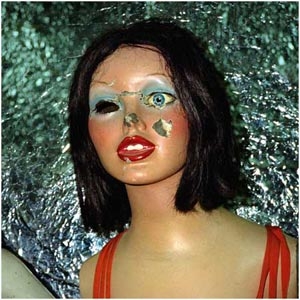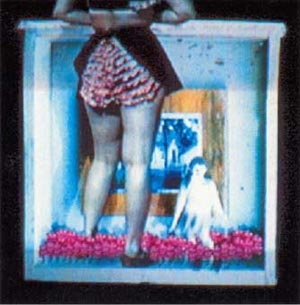Feature: Reviews
Other Selves
- Mission 17
- San Francisco
- December 12 - January 17, 2004
Showroom Dummies
A new gallery on the corner of Mission and 17th Streets currently hosts a three-woman show titled Other Selves, featuring Kimberlee Koym, Amie Potsic, and Jennifer Rosenberg. The exhibition ostensibly addresses issues of identity through various, if unsurprising, lenses: self-portraiture, the family, domesticity, and the body. That said, each artist’s works breathe comfortably and interact confidently and honestly in the small, one room gallery.
We are first arrested by the size and placement of Amie Potsic’s Doppelganger series, a grid of fifteen large, square chromogenic photographs. Twelve are busts of damaged mannequins, apparently from Peru. These are sure to be a hit with the fashionably minded, stylistically referring to the style of Kraftwerk’s Showroom Dummies. Each stares out of its square with cold, cheerful eyes (if it has them) and an open-mouthed smile. The three remaining photographs, placed one in each row, are portraits of the artist. Each self-portrait shows Potsic successively recovering from a facial injury. Her mien and surroundings are bland and featureless. The impression is that she thinks she should deny her own character to bring her image closer to that of the mannequins’, but they are so flashy and dynamic that she’s only distanced herself further. The injuries become the only point of contact, obvious and undemanding of the viewer. The pictures of the mannequins are charming. She’s not only unlocked the expected creepiness of them; she’s gone beyond into witty, stylized science fiction. With the death of Dolly the cloned sheep in the recent news, I fancied these affable freaks to be outcast mistakes from our gene altering future. Illuminated by a flash, as if caught mid-sentence, they are also morbidly enthusiastic sales creatures — quasi-humans, unaware how shocking we find their damaged heads and peeling skin, who will stop at nothing to sell us a shiny rayon blouse. The carnival of viewing and construing these colorful characters is closed down too early by the artist’s self-portraits. Potsic became interested in these mannequins because of her past work, and I think she could have followed this project further into new territory. By centering the conceptual focus on her healing process, she has resorted to didactically weaving this in with her prior work. She’s blocked open interpretation and forces us to consider the old hats of the self, the body, the healing process, etc., themes that show up in her earlier black-and-white pictures on the subject of scars.
Opposite hangs Jennifer Rosenberg’s Family Series. These highly controlled photographic depictions of a family are presented salon style, allowing our gaze to meander without being pressured by a linear narrative. The experience is closer to real perception: the eye hopping around and the mind networking images with a loose web of associations. The characters here are ensconced in a sanguine world of eroticism. There is rarely action, but each photograph contains traces of sexual interaction. They draw power from the juxtaposition of these latent insinuations and the viewer’s awareness that this is a family. Those images that stray from the principle of languorous non-action (such as the mother crying or people posing for the camera) still adhere to a tangential sexuality through devices such as references to erotic ritualism or the ancient Greeks. By filtering her family structure through sexually charged scenarios, Rosenberg toys with the documentary nature of photography. We’re provided all-access admission to a secret tryst, yet when it comes to truly comprehending this family, we’re never allowed past the threshold. As with Potsic, Rosenberg is sharp with a camera. Her compassion for her subject sometimes recalls the bracing, empathetic Nan Goldin. Her style of blending staged scenes with chance occurrence owes much to American photographer Philip Lorca diCorsia, who deftly theatricizes the quotidian.
While taking in Potsic and Rosenberg, we were continually aware of a repeating audio monologue with vacillating computer effects applied to the voice issuing from the two channel video installation, Virginia’s Moving Blue House by Kimberlee Koym. A vaguely old-fashioned table chair and a French Renaissance-style sideboard are attached to the wall, both supporting old television monitors at roughly eye level. The monologue is a passage from Mrs. Dalloway, by Virginia Woolf. Koym uses this literary reference not as an inspiration, but as a framework over which to drape video collage. Koym has created shallow virtual spaces filled with gesticulating human bodies (both real and animated) and other imagery inside the paradigm of a dreamily Victorian aesthetic. Koym is in control of her rhythm and capable of holding the viewer’s lazy attention. The eye travels forward through time on these videos the way it does on the surface of a good abstract painting: arriving and departing from points everywhere continually. Like abstract painting, or the writing of Woolf herself, the power of this installation is in the realm of technique; here we appreciate its novelty as a fresh approach to image making. Also like much abstract painting, it falls short conceptually by not achieving the lofty intent of the artist. In her written statement Koym muddles through ideas about the body as kinetic object, and the relativity of time in the mind and for the body. It’s not always wrong (nor certainly is it uncommon) for artists to pronounce philosophical intimations about their work that aren’t detected by even the most sensitive viewer. The danger, though, is that they often inhibit their own growth by not mastering a clear understanding of those ideas.
This was a fine start for this new Mission district gallery (its second show). The San Francisco art community should take note. This is a space committed to showing serious art. Director Clark Buckner, a Ph.D. candidate in philosophy at Vanderbilt University with an eye on contemporary art, is free to curate at will and with abandon, because the rent is paid for by the attached Blue Studio. Interested in but not committed to mining the undiscovered, his taste thus far seems to be for established artists who maintain a polished air in their work and draw a crowd. Those featured in this show and the last have impressive CVs: a Canadian professional artist and a couple of teachers at top Bay Area art institutions. However, for the time being at least, Buckner is approaching anything he finds intriguing and has given thought to some very young artists. Under his direction we can expect this to be a new forum in San Francisco for those interested in challenging art.
Other Selves is on view at Mission 17, 2111 Mission St @ 17th, San Francisco, CA. Hours are Tuesdays 3pm - 6pm and Saturdays 2pm - 5pm. There is a closing reception on Saturday, January 17th, 2pm - 5pm. Call (415) 336-2349 for more information.



